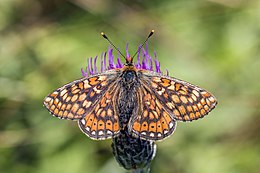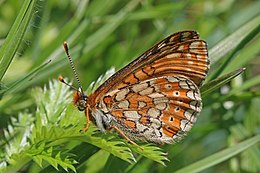| Euphydryas aurinia | |
|---|---|
| Male E. a. aurinia, Dorset | |
| Female E. a. aurinia, Dorset | |
| Scientific classification | |
| Domain: | Eukaryota |
| Kingdom: | Animalia |
| Phylum: | Arthropoda |
| Class: | Insecta |
| Order: | Lepidoptera |
| Family: | Nymphalidae |
| Genus: | Euphydryas |
| Species: | E. aurinia
|
| Binomial name | |
| Euphydryas aurinia (Rottemburg, 1775)
| |
| Synonyms[2] | |
|
List
| |
The marsh fritillary (Euphydryas aurinia) is a butterfly of the family Nymphalidae. Commonly distributed in the Palearctic region, the marsh fritillary's common name derives from one of its several habitats, marshland. The prolonged larval stage lasts for approximately seven to eight months and includes a period of hibernation over the winter. The larvae are dependent on the host food plant Succisa pratensis not only for feeding but also for hibernation, because silken webs are formed on the host plant as the gregarious larvae enter hibernation. Females lay eggs in batches on the host plant and are, like other batch-layers, selective about the location of oviposition because offspring survivorship levels for batch-layers are more tied to location selection than they are for single-egg layers.
As of 2019 the butterfly's global conservation status is considered of least concern, but it has faced rapid decline and is considered regionally vulnerable or endangered over much of its range.
- ^ van Swaay, C.; Wynhoff, I.; Wiemers, M.; et al. (2014). "Euphydryas aurinia". IUCN Red List of Threatened Species. 2014: e.T174182A53714349. Retrieved 29 October 2021.
- ^ Euphydryas aurinia (Rottemburg, 1775) Goldener Scheckenfalter. Lepiforum.de


